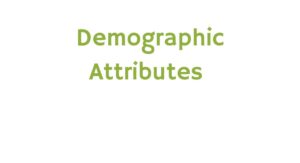Demographic attributes refer to characteristics and traits that describe a population or a specific group of people. These attributes provide insights into the composition, characteristics, and trends of a particular population. Demographic attributes are commonly used in various fields such as sociology, marketing, economics, and public policy to understand and analyze different aspects of a population.

Here are some key demographic attributes:
- Age: Age is a fundamental demographic attribute that refers to the number of years a person has lived. It helps classify populations into different age groups such as children, teenagers, adults, and seniors. Age influences various aspects of life, including behavior, health, and consumer preferences.
- Gender: Gender refers to the social and cultural roles, behaviors, and identities associated with being male or female. It is an essential demographic attribute that helps analyze gender-specific patterns and disparities in areas such as employment, education, and healthcare.
- Ethnicity and Race: Ethnicity and race describe the cultural, ancestral, and geographical backgrounds of individuals. These demographic attributes help understand the diversity within a population and examine social, economic, and health disparities among different ethnic and racial groups.
- Socioeconomic Status: Socioeconomic status (SES) combines various factors such as income, occupation, education, and wealth to determine an individual’s or household’s social and economic position. SES influences access to resources, opportunities, and quality of life.
- Education: Education level indicates the highest level of formal education attained by an individual. It is an important demographic attribute that affects employment prospects, income levels, and social mobility.
- Marital Status: Marital status refers to the legal and social status of an individual in relation to marriage. It includes categories such as single, married, divorced, widowed, or separated. Marital status can provide insights into family structures, household composition, and social dynamics.
- Household Size: Household size refers to the number of people living in a household. It helps analyze housing needs, consumption patterns, and resource allocation within a household.
- Geographic Location: Geographic location denotes the physical location of individuals or groups, such as country, city, or region. It plays a crucial role in understanding regional differences in demographics, culture, and socioeconomic conditions.
These demographic attributes provide a foundation for understanding and analyzing populations. They help researchers, policymakers, and marketers make informed decisions, develop targeted strategies, and address specific needs within different demographic groups. By studying demographic attributes, we can gain insights into population dynamics, trends, and patterns, enabling us to better understand and serve diverse populations.
Important Links